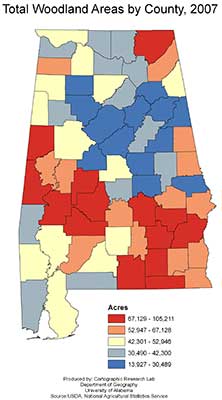Learn
Early Forest History
According to the Alabama Forestry Association, the South's forest resources are both abundant and remarkably diverse. They nurture our cultural development, support our economic well-being, and improve our quality of life.
The forests have gone through many changes. The forests we have today are no longer the original or earliest forest. Even with those changes, the climate, soils, topography, and plant species themselves profoundly impact forest structure and composition.
Think back about your favorite tree we talked about in the introduction. When you sit under it, play on it, or even just look at it and enjoy it, do you feel like you are using it? Abusing it? or are you utilizing it for what it was meant for?
Beginning with Native Americans, followed by European settlers, and continuing through the modern age of forest management, people have used, abused, and re-created the forests of the South.
Early Forest History
Watch Discovering Alabama: Early Forest History. You will need the information in this video to complete 1.01 Early Forest History.
First Native Americans
Historians tell us that the arrival of the first Native Americans to North America via the Bering Land Bridge is thought to have occurred around 12,500 YBP (Year Before Present). These earliest peoples are referred to as the Paleo-Indians and Clovis people.
Following them were the Archaic (8,000-2,800 YBP) and the Woodland (2,800-1,300 YBP) cultures.
All these groups used the forests and wildlife to help themselves. They also used fire to manage the landscape for specific plant species.\
Farming and Native Americans
Toward the end of the Woodland period, Native Americans transitioned from a nomadic lifestyle to a more settled community. The Mississippian (1,300-400 YBP) Native Americans led the way in farming and growing crops. Experts say these settlements moved every 50-100 years due to depletion of firewood supplies and reduction in soil productivity.
According to the Alabama Forestry Federation, the Native American population may have had an impact on the forests of the Southeastern United States in three ways:
- Their huge population, estimated to be between 1.5 to 2 million people
- Their use of fire
- Their tendency to move whole communities fairly frequently
These three things may have helped influence the variety of forest types, ages, and conditions of the Southeastern forests as well as treeless grassy fields.
The gradually shifting of forest types also provided habitat diversity which allowed, and may even have guaranteed, the sustenance of a wide variety of wildlife.
Settlement Period History
Watch Discovering Alabama: The Settlement Period. You will need the information in this video to complete 1.01 Settlement Period.
European Settlers
European settlers arriving in the South saw the forests as both an obstacle to progress and an unlimited resource.
European settlers started arriving in the late 1700s and early 1800s. The first thing most needed was open land on which to grow crops and graze their livestock.
In addition, timber removed from the forest was used for fuel. Wood still supplied more than 90% of the U.S. heat energy needs in the 1800s. This often created wood shortages around larger and older settlements.
Civil War
The Civil War made heavy demands on forest resources for fuel, equipment, supplies, and fortifications.
However, the South's most pressing need immediately after the war was restoration of the regional infrastructure and economy. Increased demand for a new "cash crop" to finance reconstruction in addition to an increased demand for Southern timber across the U.S impacted the Southern forest.
The South's "First Forest" had fallen. By the 1920s virtually all of the original forest the pioneers encountered had been razed to build a would-hungry nation.
Currently
The state of Alabama has a total of 33 million acres.
The Alabama Forestry Commission estimates that of those 33 million acres, there are currently 22.9 million acres that are forest land.
The lowest amount of forest land occured in the early 1900s. At that time there were an estimated 18.0 million acres classified as forest.

Alabama's Forest Action Plan
In 2010, the Alabama Forestry Commission collaborated with 33 organizations and the public to create Alabama's Forest Action Plan.
The Forest Action Plan identifies priority forest areas, forest threats, and strategies to address those threats.
Threats to Alabama's Forests:
There are nine threats to Alabama's Forest Resource covered by the Alabama Forest Plan:
- Urban Growth and Development
- Fragmentation and Parcelization
- Invasive Species
- Changing Markets
- Insects and Diseases
- Wildfire
- Catastrophic Natural Events
- Air Quality
- Climate Change
Priorities:
Alabama's Forest Plan lists four multi-state regional priorities affecting Alabama's forests. While these priorities are challenges, they also present opportunities to work with other states to solve these issues.
- Battling the problem of cogongrass
- Working to restore longleag pine
- Improving water quality
- Managing the impact of urban mega-regions that are spreading across the region